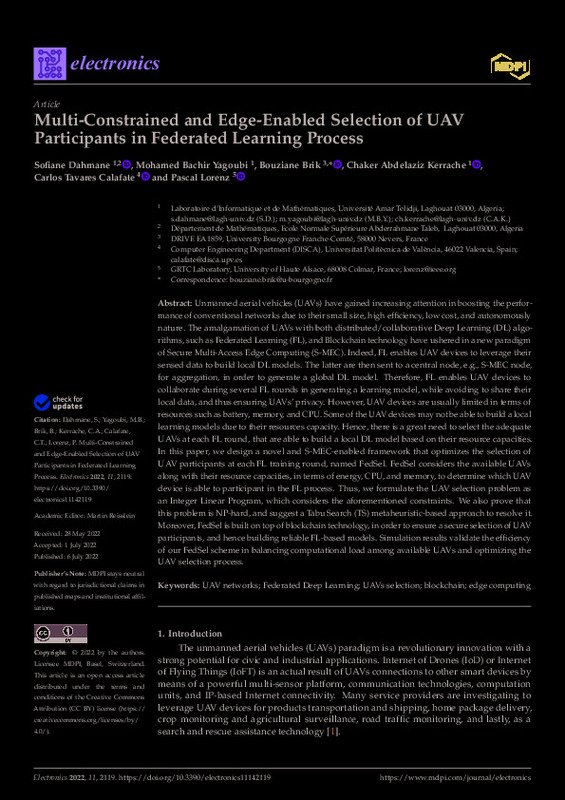JavaScript is disabled for your browser. Some features of this site may not work without it.
Buscar en RiuNet
Listar
Mi cuenta
Estadísticas
Ayuda RiuNet
Admin. UPV
Multi-Constrained and Edge-Enabled Selection of UAV Participants in Federated Learning Process
Mostrar el registro sencillo del ítem
Ficheros en el ítem
| dc.contributor.author | Dahmane, Sofiane
|
es_ES |
| dc.contributor.author | Yagoubi, Mohamed Bachir
|
es_ES |
| dc.contributor.author | Brik, Bouziane
|
es_ES |
| dc.contributor.author | Kerrache, Chaker Abdelaziz
|
es_ES |
| dc.contributor.author | Tavares De Araujo Cesariny Calafate, Carlos Miguel
|
es_ES |
| dc.contributor.author | Lorenz, Pascal
|
es_ES |
| dc.date.accessioned | 2023-05-08T18:02:08Z | |
| dc.date.available | 2023-05-08T18:02:08Z | |
| dc.date.issued | 2022-07 | es_ES |
| dc.identifier.uri | http://hdl.handle.net/10251/193215 | |
| dc.description.abstract | [EN] Unmanned aerial vehicles (UAVs) have gained increasing attention in boosting the performance of conventional networks due to their small size, high efficiency, low cost, and autonomously nature. The amalgamation of UAVs with both distributed/collaborative Deep Learning (DL) algorithms, such as Federated Learning (FL), and Blockchain technology have ushered in a new paradigm of Secure Multi-Access Edge Computing (S-MEC). Indeed, FL enables UAV devices to leverage their sensed data to build local DL models. The latter are then sent to a central node, e.g., S-MEC node, for aggregation, in order to generate a global DL model. Therefore, FL enables UAV devices to collaborate during several FL rounds in generating a learning model, while avoiding to share their local data, and thus ensuring UAVs' privacy. However, UAV devices are usually limited in terms of resources such as battery, memory, and CPU. Some of the UAV devices may not be able to build a local learning models due to their resources capacity. Hence, there is a great need to select the adequate UAVs at each FL round, that are able to build a local DL model based on their resource capacities. In this paper, we design a novel and S-MEC-enabled framework that optimizes the selection of UAV participants at each FL training round, named FedSel. FedSel considers the available UAVs along with their resource capacities, in terms of energy, CPU, and memory, to determine which UAV device is able to participant in the FL process. Thus, we formulate the UAV selection problem as an Integer Linear Program, which considers the aforementioned constraints. We also prove that this problem is NP-hard, and suggest a Tabu Search (TS) metaheuristic-based approach to resolve it. Moreover, FedSel is built on top of blockchain technology, in order to ensure a secure selection of UAV participants, and hence building reliable FL-based models. Simulation results validate the efficiency of our FedSel scheme in balancing computational load among available UAVs and optimizing the UAV selection process. | es_ES |
| dc.description.sponsorship | This work is derived from R&D project RTI2018-096384-B-I00, funded by MCIN/AEI/10.13039/501100011033 and "ERDF A way of making Europe". | es_ES |
| dc.language | Inglés | es_ES |
| dc.publisher | MDPI AG | es_ES |
| dc.relation.ispartof | Electronics | es_ES |
| dc.rights | Reconocimiento (by) | es_ES |
| dc.subject | UAV networks | es_ES |
| dc.subject | Federated Deep Learning | es_ES |
| dc.subject | UAVs selection | es_ES |
| dc.subject | Blockchain | es_ES |
| dc.subject | Edge computing | es_ES |
| dc.subject.classification | ARQUITECTURA Y TECNOLOGIA DE COMPUTADORES | es_ES |
| dc.title | Multi-Constrained and Edge-Enabled Selection of UAV Participants in Federated Learning Process | es_ES |
| dc.type | Artículo | es_ES |
| dc.identifier.doi | 10.3390/electronics11142119 | es_ES |
| dc.relation.projectID | info:eu-repo/grantAgreement/AEI//RTI2018-096384-B-I00-AR//SOLUCIONES PARA UNA GESTION EFICIENTE DEL TRAFICO VEHICULAR BASADAS EN SISTEMAS Y SERVICIOS EN RED/ | es_ES |
| dc.rights.accessRights | Abierto | es_ES |
| dc.contributor.affiliation | Universitat Politècnica de València. Escola Tècnica Superior d'Enginyeria Informàtica | es_ES |
| dc.description.bibliographicCitation | Dahmane, S.; Yagoubi, MB.; Brik, B.; Kerrache, CA.; Tavares De Araujo Cesariny Calafate, CM.; Lorenz, P. (2022). Multi-Constrained and Edge-Enabled Selection of UAV Participants in Federated Learning Process. Electronics. 11(14):1-14. https://doi.org/10.3390/electronics11142119 | es_ES |
| dc.description.accrualMethod | S | es_ES |
| dc.relation.publisherversion | https://doi.org/10.3390/electronics11142119 | es_ES |
| dc.description.upvformatpinicio | 1 | es_ES |
| dc.description.upvformatpfin | 14 | es_ES |
| dc.type.version | info:eu-repo/semantics/publishedVersion | es_ES |
| dc.description.volume | 11 | es_ES |
| dc.description.issue | 14 | es_ES |
| dc.identifier.eissn | 2079-9292 | es_ES |
| dc.relation.pasarela | S\468678 | es_ES |
| dc.contributor.funder | AGENCIA ESTATAL DE INVESTIGACION | es_ES |
| dc.contributor.funder | European Regional Development Fund | es_ES |








